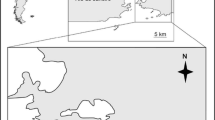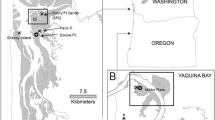Abstract
This study investigated whether surface hole counts could be used as a reliable estimate of density of the ghost shrimps Trypaea australiensis Dana 1852 and Biffarius arenosus Poore 1975 (Decapoda, Thalassinidea) in south eastern Australia. The relationship between the number of holes and the number of ghost shrimps was explored in two ways. Resin casts were used to document any changes in the number of burrow openings per shrimp burrow over time. Manual suction pumping (bait pumping) within a given mudflat area was used to directly compare the number of holes on the sediment surface with the number of ghost shrimps occupying the corresponding volume of sediment. Resin casting showed that throughout the year, the burrows of T. australiensis consistently had an average of two openings, whereas the burrows of B. arenosus showed much greater variability over time with two to four openings per burrow. Overall, a significant relationship between the number of holes and the number of ghost shrimps (mixed species populations) was found, with 2.1 burrow openings for each ghost shrimp. However, some temporal and spatial variation was seen in this relationship. We suggest that the hole count method may be reliable in estimating ghost shrimp densities with restricted use and site specific validation based on some limitations found in this study.









Similar content being viewed by others
References
Barros, F., 2001. Ghost crabs as a tool for rapid assessment of human impacts on exposed sandy beaches. Biological Conservation 97: 399–404.
Berkenbusch, K. & A. A. Rowden, 1998. Population dynamics of the burrowing ghost shrimp Callianassa filholi on an intertidal sandflat in New Zealand. Ophelia 49: 55–69.
Berkenbusch, K. & A. A. Rowden, 2000. Intraspecific burrow plasticity of an intertidal population of Callianassa filholi (Crustacea: Decapoda: Thalassinidea) in relation to environmental variables. New Zealand Journal of Marine and Freshwater Research 34: 397–408.
Bird, F. L. & G. C. B. Poore, 1999. Functional burrow morphology of Biffarius arenosus (Decapod: Callianassidae) from southern Australia. Marine Biology 134: 77–87.
Candisani, L. C., Sumida P. Y. G. & A. M. S. Pires-Vanin, 2001. Burrow morphology and mating behaviour of the thalassinidean shrimp Upogebia noronhensis. Journal of Marine Biological Association of the United Kingdom 81: 799–803.
Coelho, V. R., R. A. Cooper & S. de Almeida Rodrigues, 2000. Burrow morphology and behavior of the mud shrimp Upogebia omissa (Decapoda: Thalassinidea: Upogebiidae). Marine Ecology-Progress Series 200: 229–240.
Contessa, L. & F. L. Bird, 2004. The impact of bait-pumping on populations of the ghost shrimp Trypaea australiensis Dana (Decapoda: Callianassidae) and the sediment environment. Journal of Experimental Marine Biology and Ecology 304: 75–97.
Dumbauld, B. R., D. A. Armstrong & K. L. Feldman, 1996. Life-history characteristics of two sympatric Thalassinidean shrimps, Neotrypaea californiensis and Upogebia pugettensis, with implications for oyster culture. Journal of Crustacean Biology 16: 689–708.
Dworschak, P. C., 2001. The Burrows of Callianassa tyrrhena (Petagna 1792) (Decapoda: Thalassinidea). Marine Ecology 22: 155–166.
Griffis, R. B. & F. L. Chavez, 1988. Effects of sediment type on burrows of Callianassa californiensis Dana and C. gigas Dana. Journal of Experimental Marine Biology and Ecology 117: 239–253.
Griffis, R. B. & T. H. Suchanek, 1991. A model of burrow architecture and trophicmodes in thalassinidean shrimp (Decapoda: Thalassinidea). Marine EcologyProgress Series 79: 171–183.
Hailstone, T. S. & W. Stephenson, 1961. The biology of Callianassa (Trypaea) australiensis Dana 1852 (Crustacea, Thalassinidea). University of Queensland Papers 12: 259–283.
Kenway, M., 1981. Biological studies of Callianassa australiensis (Dana). Honours Thesis. James Cook University, North Queensland.
McPhee, D. P. & G. A. Skilleter, 2002. Aspects of the biology of the yabby Trypaea australiensis (Dana) (Decapoda: Thalassinidea) and the potential of burrow counts as an indirect measure of population density. Hydrobiologia 485: 133–141.
Morrisey, D. J., S. J. Turner & A. B. MacDiarmid, 1998. Subtidal assemblages of soft substrata. In Kingsford, M. & C. Battershill (eds.), Studying Temperate Marine Environments: A Handbook for Ecologists. Canterbury University Press, New Zealand: 194–226.
Nickell, L. A. & R. J. A. Atkinson, 1995. Functional morphology of burrows and trophic modes of three thalassinidean shrimp species, and a new approach to the classification of thalassinidean burrow morphology. Marine Ecology-Progress Series 128: 181–197.
Poore, G. C. B., 2004. Marine Decapod Crustacea of southern Australia: A Guide to Indentification. CSIRO Publishing, Australia.
Robertson, A. I., 1977. Ecology of juvenile King George Whiting Sillaginodes punctatus (Cuvier & Valenciennes) (Pisces: Perciformes) in Western Port, Victoria. Australian Journal of Marine and Freshwater Research 28: 35–43.
Rotherdam, D. & West, R. J. 2003. Comparison of methods for sampling populations of ghost shrimp Trypaea australiensis (Decapoda: Thalassinidea: Callianassidae). Fisheries Research (Amsterdam) 60: 585–591.
Rowden, A. A. & M. B. Jones, 1995. The burrow structure of the mud shrimp Callianassa subterranea (Decapoda: Thalassinidea) from the North Sea. Journal of Natural History 29: 1155–1165.
Skilleter, G. A., 1996. An experimental test of artifacts from repeated sampling in soft-sediments. Journal of Experimental Marine Biology and Ecology 205: 137–148.
Skilleter, G. A., Y. Zharikov, B. Cameron & D. P. McPhee, 2005. Effects of harvesting callianassid (ghost) shrimps on subtropical benthic communities. Journal of Experimental Marine Biology and Ecology 320: 133–158.
Stapleton, K. L., M. Long & F. L. Bird, 2002. Comparative feeding ecology of two spatially coexisting species of ghost shrimp, Biffarius arenosus and Trypaea australiensis (Decapoda: Callianassidae). Ophelia 55: 141–150.
Tamaki, A., K. Ikebe, K. Muramatsu & B. Ingole, 1992. Utilization of adult burrows by juveniles of the ghost shrimp, Callianassa japonica Ortmann: evidence from resin casts of burrows. Researches on Crustacea 21: 113–120.
Tuck, I. D., C. J. Chapman, R. J. A. Atkinson, N. Bailey & R. S. M. Smith, 1997. A comparison of methods for stock assessment of the Norway lobster, Nephrops norvegicus, in the Firth of Clyde. Fisheries Research 32: 89–100.
Warren, J. H., 1990. The use of open burrows to estimate abundances of intertidal estuarine crabs. Australian Journal of Ecology 15: 277–280.
Wynberg, R. P. & G. M. Branch, 1991. An assessment of bait-collecting for Callianassa kraussi Stebbing in Langebaan Lagoon, Western Cape, and of associated avian predation. South African Journal of Marine Science 11: 141–152.
Zharikov, Y. & G. A. Skilleter, 2004. A relationship between prey density and territory size in non-breeding Eastern Curlews Numenius madagascariensis. Ibis 146: 518–521.
Acknowledgements
We would like to thank the many volunteers who helped with fieldwork throughout this study. Also to M. Clarke, B. Malone, and R. Zann, for valuable insight into statistical analysis and the importance of various types of analysis, and H. Butler for help with editing at various stages.
Author information
Authors and Affiliations
Corresponding author
Additional information
Handling editor: K. Martens
Rights and permissions
About this article
Cite this article
Butler, S., Bird, F.L. Estimating density of intertidal ghost shrimps using counts of burrow openings. Is the method reliable?. Hydrobiologia 589, 303–314 (2007). https://doi.org/10.1007/s10750-007-0747-x
Received:
Revised:
Accepted:
Published:
Issue Date:
DOI: https://doi.org/10.1007/s10750-007-0747-x




